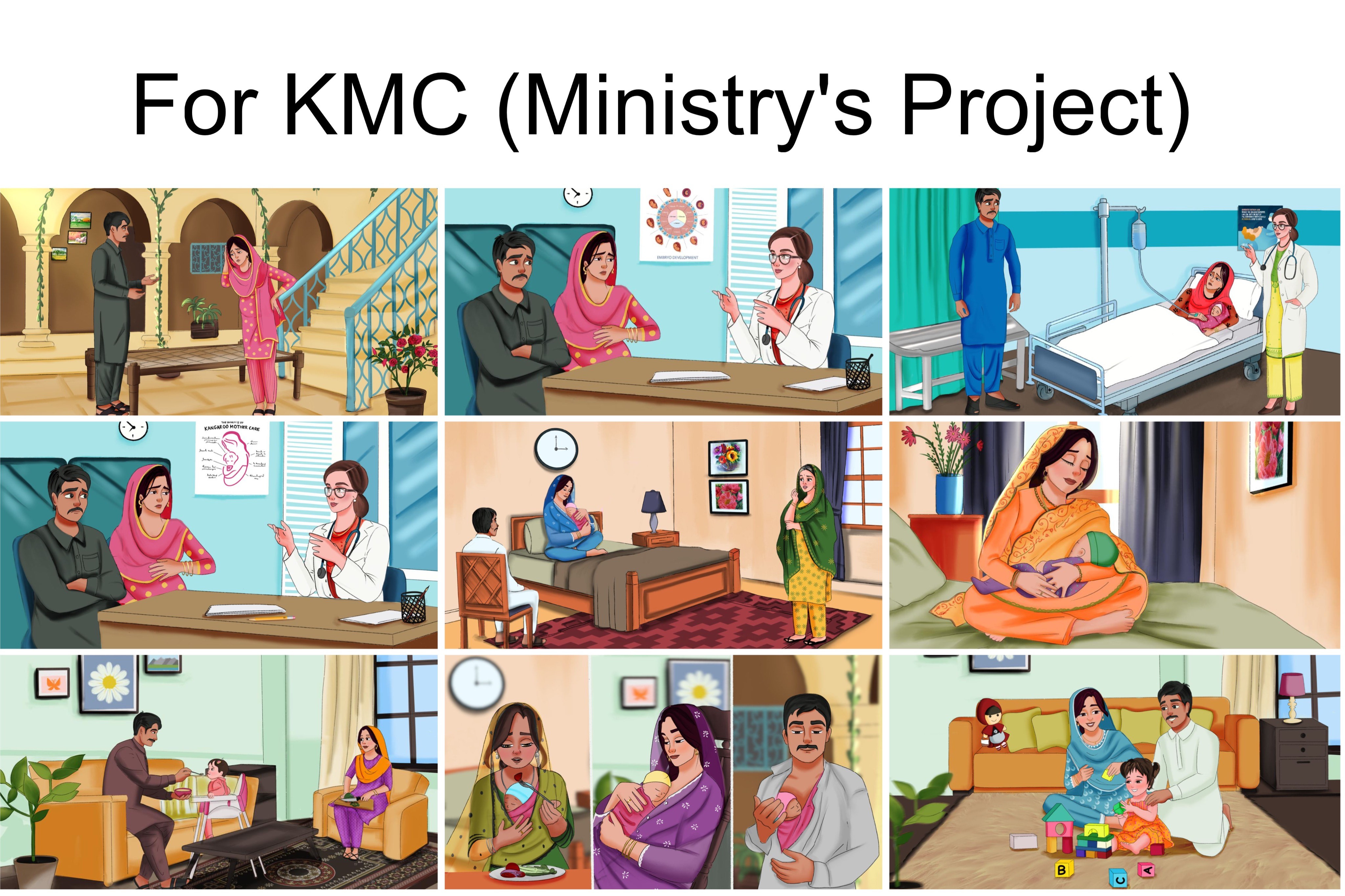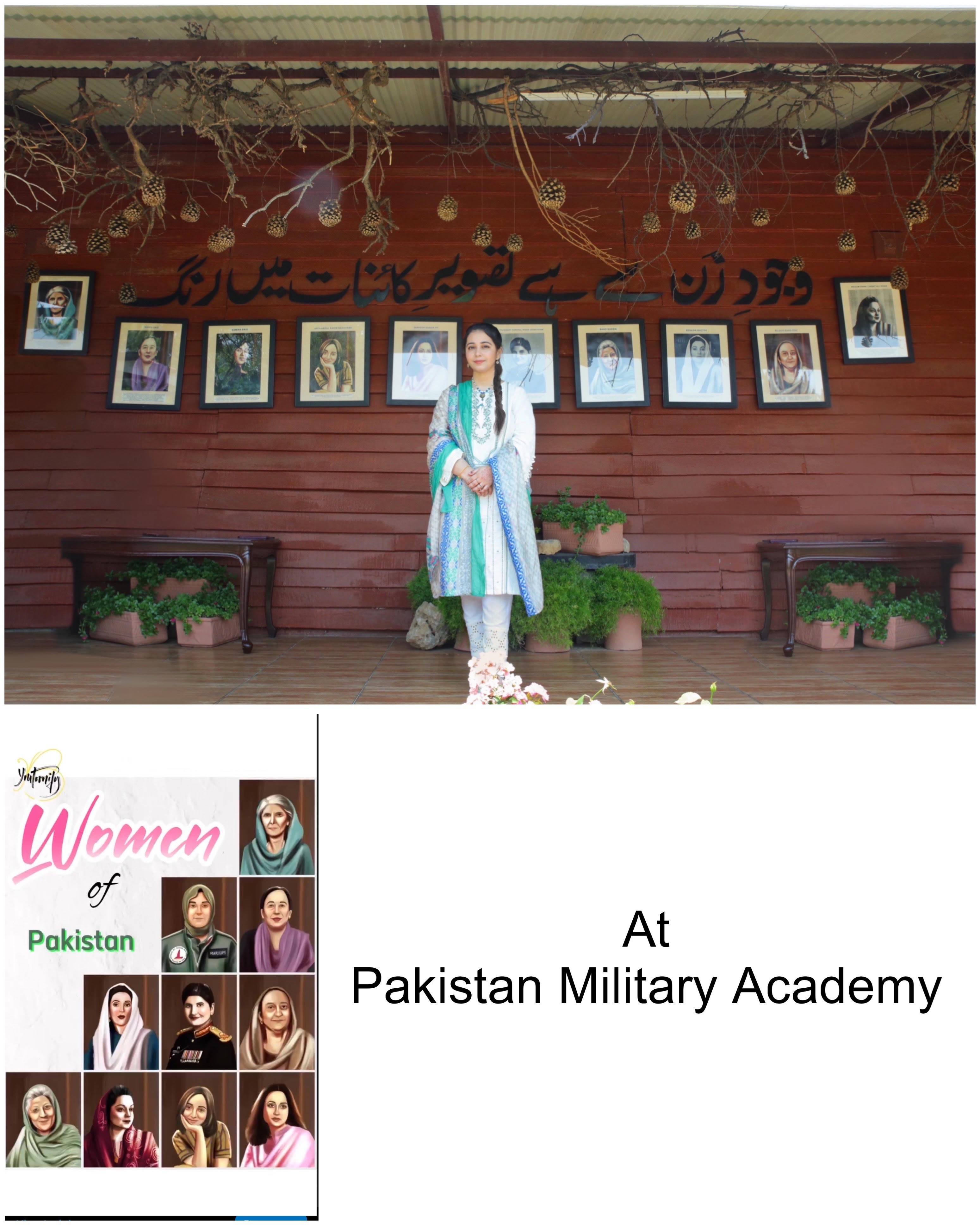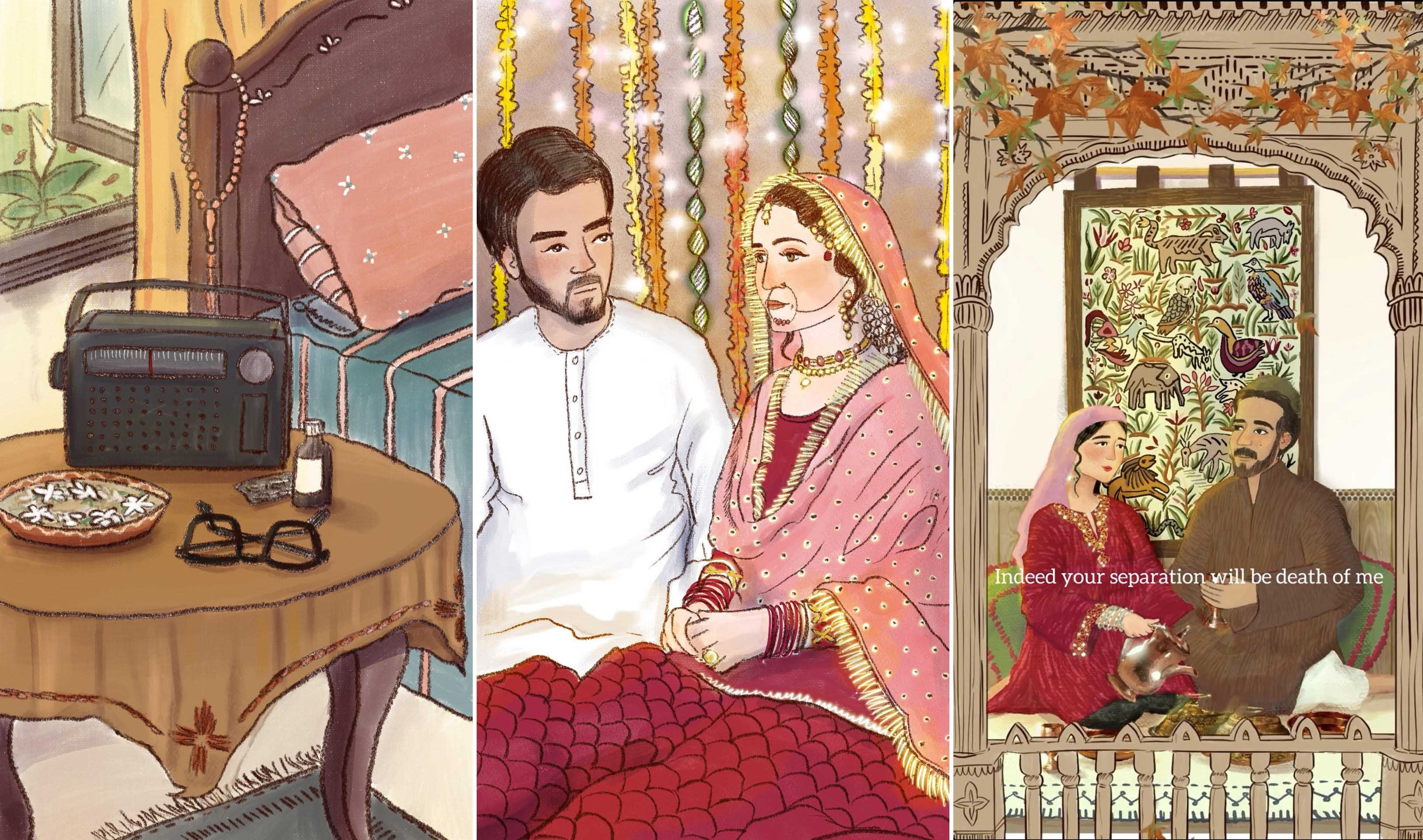Forget Van Gogh’s Sunflowers, these Pakistani prodigies are painting galaxies on their tablets! Bakhtawar Hasan's vibrant and emotionally charged illustrations can be found on her Instagram page, Youtoonify. Wasfa Kamal, known as "throughwasfa" on Instagram, showcases her artistic versatility through realistic, semi-realistic, and cartoon styles. Hira Ata, a longtime admirer of cottage-core aesthetics, infuses her vintage and distinctly Pakistani art with a touch of whimsy on her Instagram account, hira_at_work.
These three young, dynamic, self-taught digital artists are carving their own vibrant niche in the world of art from Karachi, Islamabad, and Gilgit. Explore the creative journeys of these rising stars: what fuels their inspiration, what accomplishments mark their paths, and their aspirations for the future.
Journey and inspiration
Passionate about art since her childhood, 33-year-old, Islamabad-based Hasan is an engineer. “Expression through visuals has always appealed to me,” she shares. “But I just might have inherited my passion from my super-creative parents.”
When balancing her engineering job with the demands of motherhood became difficult, she decided to shift her focus towards nurturing her artistic skills.
Ata, the 34-year-old, Gilgit-based, self-taught artist was largely inspired by her mother’s paintings from her college years. “Later, my art was encouraged in school,” she shares. “Teaching art boosted my confidence and I began to practiced traditional mediums.”
Kamal, 26, began her journey when the pandemic was at its peak. “Locked up in our homes, with nothing much to do, my cousin introduced me to an application called Dobby's Sketchbook,” she recounts. “She made my sketch which I thought needed improvement. She told me to fix it myself and I said I didn’t know how to use the app. With her encouragement, I began to draw until a time came that my sister suggested I upload my creations, even though I wasn’t very confident. Gradually I began to upload my work.”
“Cottage-core art ultimately helped me develop my style as an amalgamation of Pakistani, yet etchy, ink-hatched drawings,” Ata explains. “My childhood was vividly inspired by Pakistani books from The Book Group, and drawings in Enid Blyton and Roald Dahl books.”
Ata takes inspiration from Sue Rahel, Simone Grunewald and Toni Galmes, who are fluent in cottage core, environment and character design.

Milestones
Hasan loves creating pieces that have sentimental value. “This includes stuff like illustrating someone’s imagination, drawing their lost loved ones with them, wedding illustrations, and message-bearing work particularly for education purposes,” she elaborates.
Hasan’s work that she is particularly proud of includes 10 Portraits - Inspiring Pakistani Women, displayed at the Pakistan Military Academy, Kangaroo Mother Care project for the Ministry of Health, Hashim Ali’s truck art portrait [a huge inspiration for her], nostalgic Eid cartoons, and Omair Rana’s Simpson portrait. “I loved exploring his character in a unique art style,” she says. "I have also created work for Palestine as I believe that even the slightest effort matters.”
Both Kamal and Ata like to work on social issues but the latter prefers work where she can incorporate emotions and create thought-provoking connections through visuals,
“We live in a world full of connectivity, but nothing connects as well with the soul as art does,” she says. “Art is my tool to convey my deepest feelings without the fear of being judged.”
For Kamal, work where she is given maximum creative freedom is most enjoyable. “But usually, clients don't let you experiment,” she points out. “I’m currently working on nostalgic art and childhood memories, through which I'm getting a lot of reach.”
Talking about a collaborative Women’s Day post with Dastak, Kamal spoke about her depiction of how women feel in male-dominated public spaces. “Since I was given a lot of creative freedom for this project, the powerful depiction had great impact,” she shares. “A lot of my work on women’s issues is about having to conform to societal pressures of being and having to appear in a certain way, of having a lighter skin tone, leading a certain kind of life, and how difficult it is for women to mould themselves to someone else’s preconceived ideas.”
Ata likes to address social issues through projects that enable her to integrate emotions and establish thought-provoking connections through visuals. “When I worked with the SOS Villages and Ethnic clothing, both assignments had a brief that required an emotional connection with the audience, so I used the elements of empathy and nostalgia.”
Her project with The Asia Foundation for children marked her debut as an author-illustrator. “It was the story of a boy who loved to visit his grandparents because of a library in their home,” says Ata. “It will always be special for me.”

Tools and techniques
Hasan, who is self-taught, uses Illustrator, Sketchbook Pro, while Procreate is her favourite. “Social media has made it really easy to stay in touch with various international developments in artists’ circles that I follow,” she says.
Kamal initially used Adobe Sketchbook, but now uses Procreate, and Procreate Dreams for animation.
Ata began working with a basic old computer, a graphic tablet and Youtube. “As the years passed, I upgraded to more convenient versions of drawing tools like an Ipad,” she shares. “I use Photoshop, Procreate, Procreate Dreams and Inshot for editing and syncing.”
 Creative process
Creative process
Hasan’s work flow may be a bit different from a systematic approach, when a creative idea hits her mind, she clearly visualises. “I start with rough storyboarding and sketching, and tweak it a bit. Then I do some colour blocking followed by highlights and shadows. I keep modifying it until I am content.”
Hasan is inspired by places, people and the spirit they carry. “Something just resonates within me about these and I create something around that inspiration,” she says. “I am also hugely inspired by Arsalan Khan’s work.”
The personal projects that Kamal uploads on Instagram, are usually based on random ideas. “For instance, my dad felt like having peanuts and gajar ka halwa,” she says. “It inspired me to do a nostalgic depiction on how people used to spend winter nights huddled together in a room enjoying cold weather treats and talking. For commissioned work, I send sketches out, and after approval, brainstorming, colours and other details follow.

Deadlines and juggling acts
Due to the client-based nature of Hasan's work, timely delivery of projects is essential, which she finds challenging and exciting. “I am forever grateful to my father who inculcated the sense of discipline and punctuality in us,” she shares.
Ata becomes even more diligent as she balances deadlines, domestic duties and her children's school hours. “Once I had to deliver a whole book in less than a week,” she recalls. “I divided the amount of work among the number of days in hand and for further ease, I divided the tasks in batches of concept art, line art, colour blocking, finally adding light. Batch work on illustrations increases your productivity and maintains workflow.”
Building connections
Hasan has worked with several brands such as Batik, Zayfied, Silayipret, Yadgarcards, shadiyana, influencers such as @hirableeh, @ByRooj, @samosiiii and @samramirr, and fellow artists to visualise collective ideas.
“The process has always been smooth,” Hasan says. “Honesty, clarity and communicating professionally is the key. I want to work closely with more inspiring brands and individuals in the industry.”
Kamal who has also done a lot of collaborative work finds it a bit tricky to deliver to people who don’t understand art, and technical issues. “Things are slowly changing for the better though,” she says. “People not only support artists more, but also leave it to the artist to decide what looks better in terms of colour, composition and detailing.”
Ata finds collaborating with a creative partner an amazingly empowering and fulfilling experience. “I had a difficult client who was not satisfied with the illustrations I had made for their books,” she shares. “But it trained me to be patient with long term projects as the creative process cannot always be a breeze.”

Feedback and criticism
“How your creation is being viewed by other people, matters a lot,” Hasan says. “Feedback and criticism are an artists’ best friends. I directly deal with clients, because their critical advice always helps achieve best results.”
While Kamal is open-minded and can handle negative feedback, which she says a lot of people cannot, Ata sees criticism as room for improvement. “After all, I am only a creative person with self-taught knowledge and emotional experiences,” she points out. “The client on the other hand has a good overview of their project and a deep insight of the targets to achieve.”
Overcoming obstacles
Despite the challenges in gaining trust regarding her abilities and securing advance payments, Hasan is determined to continue bringing smiles to people's faces through the beauty of her work.
One of the biggest challenges Kamal faced was making people understand what her work is about. “When I was working with women’s issues, I was accused of making rebels out of women,” she shares. “Some people commented that I was a feminist and called me ‘Aurat-March walli’, because that too is perceived so wrongly in our society.”
Ata overcame challenging post-partum health issues with sheer will power, a manifestation of which was a comic character called Maroon Nisa that she created. “It was a slightly evolved version of Mehr-un-Nisa,” she says.

Artist’s block
Hasan claims she may run short of words but never art! For Kamal who believes art block is the worst enemy of every artist, the best solution is to take breaks. “Sooner or later, some inspiration will happen,” she says. “What is worse is that I get bored easily and need to work consistently. When I don’t have commissioned work, I should work on personal projects, sometimes I don’t do that and lose the discipline.”
Ata’s solution for for conquering the creative slump is to watch Ghibli/animated movies or visit places around Gilgit. “These places are my biggest source of motivation and calmness during days of chaos,” she says. “I also spend time studying references from other artists.”
Keeping abreast
Kamal believes it is important to stay updated on different platforms with new techniques and tools. “I learn from artists such as Olivier Bonhomme, John Holcroft and Be Fernandez,” she shares. “The internet is free and one can learn from anywhere through courses, workshops, seminars, meet-ups and webinars. You should never get stuck in a rut, and must experiment with different trends and ideas and stay inspired by surrounding yourself with books, galleries and museums.”
For Ata, acquiring new tech knowledge is crucial for her skills. “What is not upgraded can always be replaced,” she says. “We are so blessed to be living in this age as learning is a click away. When I had fewer resources, I constantly used YouTube, but as I started to earn through my work, I invested in buying online courses from established artists which helped me stay relevant and define my style.”

Reaching for the stars
Apart from recognition and respect, Kamal’s goals are to continuously improve her skills, and build a strong portfolio. “I would like to expand into new markets and mediums and collaborate with other artists and international clients, and maybe one day start a studio agency,” she says. “ I want to explore illustrations for children’s books using different techniques and character art. I also want to be proficient in animation. Creating my own animated short films or series so it would be a real plus point in my career.”
Ata and Hasan also want to learn animation.
“I want to strengthen my distinct art style,” says Hasan.
Since Ata’s responsibilities as a mother limit her freelance work, she wants to encourage other women with the same skill set to keep doing what they can. “Maybe someday we can work together remotely towards establishing a publishing house that would offer a group of versatile artists and contribute to the children's literature,” she says.
